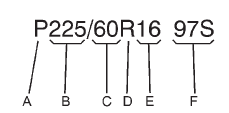Tire Designations
Tire Size
The following is an example of a typical passenger vehicle tire size.

(A) Passenger (P—Metric) Tire:
The United States version of a metric tire sizing system.
The letter P as the first character in the tire size means a passenger vehicle tire engineered to standards set by the U.S. Tire and Rim Association.
(B) Tire Width: The three—digit number indicates the tire section width in millimeters from sidewall to sidewall.
(C) Aspect Ratio: A two—digit number that indicates the tire height—to—width measurements.
For example, if the tire size aspect ratio is 60, as shown in item C of the illustration, it would mean that the tire's sidewall is 60 percent as high as it is wide.
(D) Construction Code: A letter code is used to indicate the type of ply construction in the tire. The letter R means radial ply construction; the letter D means diagonal or bias ply construction; and the letter B means belted—bias ply construction.
(E) Rim Diameter: Diameter of the wheel in inches.
(F) Service Description: These characters represent the load index and speed rating of the tire. The load index represents the load carrying capacity a tire is certified to carry. The speed rating is the maximum speed a tire is certified to carry a load.
See also:
What to Do with Used Oil
Used engine oil contains certain
elements that can be unhealthy for
your skin and could even cause
cancer. Do not let used oil stay on
your skin for very long. Clean your
skin and nails with ...
Exterior
Cadillac says stealth fighters inspired the XLR, which serves as "a
contemporary expression of Cadillac's heritage of landmark design and advanced
technology." Linear lines display hints ...
SERVICE TIRE MONITOR
SYSTEM
This message displays if a part on
the Tire Pressure Monitor System
(TPMS) is not working properly.
The tire pressure light also flashes
and then remains on during the
same ignition cycle. Se ...






